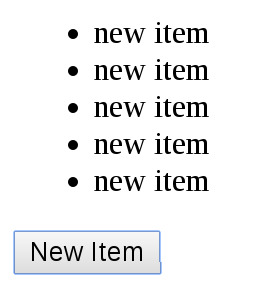九、致谢
最后更新于:2022-04-01 22:36:26
## 九、致谢
本文受到了Andrew Ray 的文章[《Flux For Stupid People》](http://blog.andrewray.me/flux-for-stupid-people/)的启发。
(完)
';
八、View (第二部分)
最后更新于:2022-04-01 22:36:24
## 八、View (第二部分)
现在,我们再回过头来修改 [View](https://github.com/ruanyf/extremely-simple-flux-demo/blob/master/components/MyButtonController.jsx) ,让它监听 Store 的 `change` 事件。
> ~~~
> // components/MyButtonController.jsx
> var React = require('react');
> var ListStore = require('../stores/ListStore');
> var ButtonActions = require('../actions/ButtonActions');
> var MyButton = require('./MyButton');
>
> var MyButtonController = React.createClass({
> getInitialState: function () {
> return {
> items: ListStore.getAll()
> };
> },
>
> componentDidMount: function() {
> ListStore.addChangeListener(this._onChange);
> },
>
> componentWillUnmount: function() {
> ListStore.removeChangeListener(this._onChange);
> },
>
> _onChange: function () {
> this.setState({
> items: ListStore.getAll()
> });
> },
>
> createNewItem: function (event) {
> ButtonActions.addNewItem('new item');
> },
>
> render: function() {
> return items={this.state.items}
> onClick={this.createNewItem}
> />;
> }
> });
> ~~~
上面代码中,你可以看到当`MyButtonController` 发现 Store 发出 `change` 事件,就会调用 `this._onChange` 更新组件状态,从而触发重新渲染。
> ~~~
> // components/MyButton.jsx
> var React = require('react');
>
> var MyButton = function(props) {
> var items = props.items;
> var itemHtml = items.map(function (listItem, i) {
> return {listItem} ;
> });
>
> return
';
>
;
> };
>
> module.exports = MyButton;
> ~~~
- {itemHtml}
七、Store
最后更新于:2022-04-01 22:36:22
## 七、Store
Store 保存整个应用的状态。它的角色有点像 MVC 架构之中的Model 。
在我们的 Demo 中,有一个[`ListStore`](https://github.com/ruanyf/extremely-simple-flux-demo/blob/master/stores/ListStore.js),所有数据都存放在那里。
> ~~~
> // stores/ListStore.js
> var ListStore = {
> items: [],
>
> getAll: function() {
> return this.items;
> },
>
> addNewItemHandler: function (text) {
> this.items.push(text);
> },
>
> emitChange: function () {
> this.emit('change');
> }
> };
>
> module.exports = ListStore;
> ~~~
上面代码中,`ListStore.items`用来保存条目,`ListStore.getAll()`用来读取所有条目,`ListStore.emitChange()`用来发出一个"change"事件。
由于 Store 需要在变动后向 View 发送"change"事件,因此它必须实现事件接口。
> ~~~
> // stores/ListStore.js
> var EventEmitter = require('events').EventEmitter;
> var assign = require('object-assign');
>
> var ListStore = assign({}, EventEmitter.prototype, {
> items: [],
>
> getAll: function () {
> return this.items;
> },
>
> addNewItemHandler: function (text) {
> this.items.push(text);
> },
>
> emitChange: function () {
> this.emit('change');
> },
>
> addChangeListener: function(callback) {
> this.on('change', callback);
> },
>
> removeChangeListener: function(callback) {
> this.removeListener('change', callback);
> }
> });
> ~~~
上面代码中,`ListStore`继承了`EventEmitter.prototype`,因此就能使用`ListStore.on()`和`ListStore.emit()`,来监听和触发事件了。
Store 更新后(`this.addNewItemHandler()`)发出事件(`this.emitChange()`),表明状态已经改变。 View 监听到这个事件,就可以查询新的状态,更新页面了。
';
六、Dispatcher
最后更新于:2022-04-01 22:36:19
## 六、Dispatcher
Dispatcher 的作用是将 Action 派发到 Store、。你可以把它看作一个路由器,负责在 View 和 Store 之间,建立 Action 的正确传递路线。注意,Dispatcher 只能有一个,而且是全局的。
Facebook官方的 [Dispatcher 实现](https://github.com/facebook/flux)输出一个类,你要写一个[`AppDispatcher.js`](https://github.com/ruanyf/extremely-simple-flux-demo/blob/master/dispatcher/AppDispatcher.js),生成 Dispatcher 实例。
> ~~~
> // dispatcher/AppDispatcher.js
> var Dispatcher = require('flux').Dispatcher;
> module.exports = new Dispatcher();
> ~~~
`AppDispatcher.register()`方法用来登记各种Action的回调函数。
> ~~~
> // dispatcher/AppDispatcher.js
> var ListStore = require('../stores/ListStore');
>
> AppDispatcher.register(function (action) {
> switch(action.actionType) {
> case 'ADD_NEW_ITEM':
> ListStore.addNewItemHandler(action.text);
> ListStore.emitChange();
> break;
> default:
> // no op
> }
> })
> ~~~
上面代码中,Dispatcher收到`ADD_NEW_ITEM`动作,就会执行回调函数,对`ListStore`进行操作。
记住,Dispatcher 只用来派发 Action,不应该有其他逻辑。
';
五、Action
最后更新于:2022-04-01 22:36:17
## 五、Action
每个Action都是一个对象,包含一个`actionType`属性(说明动作的类型)和一些其他属性(用来传递数据)。
在这个Demo里面,[`ButtonActions`](https://github.com/ruanyf/extremely-simple-flux-demo/blob/master/actions/ButtonActions.js) 对象用于存放所有的Action。
> ~~~
> // actions/ButtonActions.js
> var AppDispatcher = require('../dispatcher/AppDispatcher');
>
> var ButtonActions = {
> addNewItem: function (text) {
> AppDispatcher.dispatch({
> actionType: 'ADD_NEW_ITEM',
> text: text
> });
> },
> };
> ~~~
上面代码中,`ButtonActions.addNewItem`方法使用`AppDispatcher`,把动作`ADD_NEW_ITEM`派发到Store。
';
四、View(第一部分)
最后更新于:2022-04-01 22:36:15
## 四、View(第一部分)
请打开 Demo 的首页[`index.jsx`](https://github.com/ruanyf/extremely-simple-flux-demo/blob/master/index.jsx) ,你会看到只加载了一个组件。
> ~~~
> // index.jsx
> var React = require('react');
> var ReactDOM = require('react-dom');
> var MyButtonController = require('./components/MyButtonController');
>
> ReactDOM.render(
> onClick={this.createNewItem}
> />;
> }
> });
>
> module.exports = MyButtonController;
> ~~~
上面代码中,`MyButtonController`将参数传给子组件`MyButton`。后者的[源码](https://github.com/ruanyf/extremely-simple-flux-demo/blob/master/components/MyButton.jsx)甚至更简单。
> ~~~
> // components/MyButton.jsx
> var React = require('react');
>
> var MyButton = function(props) {
> return
';
>
>
;
> };
>
> module.exports = MyButton;
> ~~~
上面代码中,你可以看到[`MyButton`](https://github.com/ruanyf/extremely-simple-flux-demo/blob/master/components/MyButton.jsx)是一个纯组件(即不含有任何状态),从而方便了测试和复用。这就是"controll view"模式的最大优点。
`MyButton`只有一个逻辑,就是一旦用户点击,就调用[`this.createNewItem`](https://github.com/ruanyf/extremely-simple-flux-demo/blob/master/components/MyButtonController.jsx#L27) 方法,向Dispatcher发出一个Action。
> ~~~
> // components/MyButtonController.jsx
>
> // ...
> createNewItem: function (event) {
> ButtonActions.addNewItem('new item');
> }
> ~~~
上面代码中,调用`createNewItem`方法,会触发名为`addNewItem`的Action。
三、基本概念
最后更新于:2022-04-01 22:36:13
## 三、基本概念
讲解代码之前,你需要知道一些 Flux 的基本概念。
首先,Flux将一个应用分成四个部分。
> * View: 视图层
> * Action(动作):视图层发出的消息(比如mouseClick)
> * Dispatcher(派发器):用来接收Actions、执行回调函数
> * Store(数据层):用来存放应用的状态,一旦发生变动,就提醒Views要更新页面

Flux 的最大特点,就是数据的"单向流动"。
> 1. 用户访问 View
> 2. View 发出用户的 Action
> 3. Dispatcher 收到 Action,要求 Store 进行相应的更新
> 4. Store 更新后,发出一个"change"事件
> 5. View 收到"change"事件后,更新页面
上面过程中,数据总是"单向流动",任何相邻的部分都不会发生数据的"双向流动"。这保证了流程的清晰。
读到这里,你可能感到一头雾水,OK,这是正常的。接下来,我会详细讲解每一步。
';
二、安装 Demo
最后更新于:2022-04-01 22:36:10
## 二、安装 Demo
为了便于讲解,我写了一个[Demo](https://github.com/ruanyf/extremely-simple-flux-demo)。
请先安装一下。
> ~~~
> $ git clone https://github.com/ruanyf/extremely-simple-flux-demo.git
> $ cd extremely-simple-flux-demo && npm install
> $ npm start
> ~~~
然后,访问 http://127.0.0.1:8080 。

你会看到一个按钮。这就是我们的Demo。
';
一、Flux 是什么?
最后更新于:2022-04-01 22:36:08
## 一、Flux 是什么?
简单说,Flux 是一种架构思想,专门解决软件的结构问题。它跟[MVC 架构](http://www.ruanyifeng.com/blog/2007/11/mvc.html)是同一类东西,但是更加[简单和清晰](http://www.infoq.com/news/2014/05/facebook-mvc-flux)。
Flux存在多种实现([至少15种](https://github.com/voronianski/flux-comparison)),本文采用的是[Facebook官方实现](https://github.com/facebook/flux)。
';
前言
最后更新于:2022-04-01 22:36:06
> 出处:[阮一峰的博客](http://www.ruanyifeng.com/blog/2016/01/flux.html)
> 作者:阮一峰
过去一年中,前端技术大发展,最耀眼的明星就是[React](https://facebook.github.io/react/)。
React 本身只涉及UI层,如果搭建大型应用,必须搭配一个前端框架。也就是说,你至少要学两样东西,才能基本满足需要:React + 前端框架。
Facebook官方使用的是 [Flux 框架](https://facebook.github.io/flux/)。本文就介绍如何在 React 的基础上,使用 Flux 组织代码和安排内部逻辑,使得你的应用更易于开发和维护。

阅读本文之前,我假设你已经掌握了 React 。如果还没有,可以先看我写的[《React入门教程》](http://www.ruanyifeng.com/blog/2015/03/react.html)(注:[看云阅读版本点击这里](http://www.kancloud.cn/kancloud/react/67574))。与以前一样,本文的目标是使用最简单的语言、最好懂的例子,让你一看就会。
';